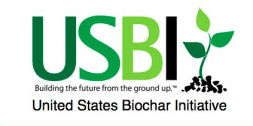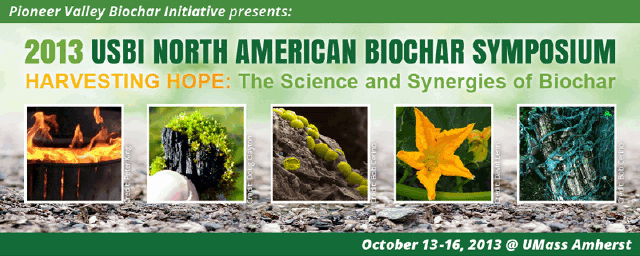Feedstocks & Production
Small Scale Devices
Streaming Media
Paul Anderson presentation
USBI'13 U Mass JRO PP.ppt (37784 kB)
Karl Frogner and Doug Clayton presentation
F&P Paul Taylor.pdf (9416 kB)
Paul Taylor presentation
Location
CC 163
Start Date
16-10-2013 1:30 PM
End Date
16-10-2013 2:50 PM
Session Description
Special Small Scale Devices Q&A video:
http://www.youtube.com/watch?v=aiMurjcpSPg
Biochar-producing Cookstoves: TLUDs and the GACC - Paul S Anderson, PhD
http://www.youtube.com/watch?v=Rzu3BxiZpGg
This and the other presentations in this session will give the attendees specific (as well as introductory) information about how you as individuals or small groups can ACTUALLY PRODUCE YOUR OWN BIOCHAR.
This can be of particular interest to:
1. Teachers / educators of any subject that relates to biochar (physical sciences, plant science, soil science, social science, etc.)
2. Experimenters interested in biochar characterization, including issues of different original biomass and the making of “designer biochars” by changing production characteristics.
3. Gardeners who also have access to sufficient dry biomass.
4. Anyone supportive of improved cookstoves for impoverished people, including supporters of NGOs working overseas.
Production of biochar in small amounts is commonly associated with cooking stoves called TLUD (tee-lud = Top-Lit UpDraft) gasifiers. TLUD pyrolysis is explained and presented in the context of GACC world-wide efforts to introduce 100 million improved cookstoves into impoverished households. Availability of such stoves in North America is discussed, including Do-It-Yourself options, the pros and cons of such devices, and the potential for introduction of biochar studies into school curricula. This presentation is a good introduction for some activities at the Biochar Tech Field Day on Thursday after the conference.
Conversion of Biomass to Biochar in larger custom-built kiln devices - Paul Taylor, PhD. Mt. Warning, NSW, AU
http://www.youtube.com/watch?v=eitodgdB9Dk
Small property holders, small farmers and community gardeners seek small-scale biochar production devices that process their waste biomass into biochars or enhanced biochars suitable for their soils. They seek to accomplish this with modest budgets in the $100’s to $30,000 range. In this talk we discuss the principals, fuel supply and quality, energy balance, heating methods, emissions levels and regulatory and safety issues relevant to small-scale kiln design. We exemplify with experience in Australia developing batch reactors ranging in size from recycled 55 gal (200 L) drums, through small in-field pyrolyzers, up to 1 and 2 cubic meter cart kilns, and shipping container sized. We also refer to small continuous feed pyrolyzers developed in farm based enterprises in Australia. We include the use of advanced computational fluid dynamics and combustion models to help optimize the designs. Emphasis has been placed on developing integrated systems that allow farmers to use biochar at low application rates. Two systems will be highlighted: one provides process heat for animal pens, and combines the biochar with compost into a granulated pellet; the other produces a synthetic terra preta granule that can be fully organic or a mixture of chemical, minerals and biochar.
Jolly Roger Ovens - Biochar making devices for gardeners and small farmers in North America: Karl Frogner & Doug Clayton
http://www.youtube.com/watch?v=IGsdma-2CkQ
“Jolly Roger Ovens” (J-RO’s), inspired John Rogers’ work with 200 liter TLUD’s, are a family of biochar making devices capable of producing 1 to 3 cu-ft per hour of high adsorbing biochar from thinly distributed but widely available feedstocks. Constructed from steel drums and commonly available components, they are easy to build and with minimal practice can perform in a clean, smoke free, manner.
While large TLUD’s are often thought to be the province of the developing world (e.g. the work of RE:Char), they also may fill the unmet demand for biochar in the forward thinking, early adopter, communities of organic growers, community organizations, permaculture enthusiasts, etc.
The presentation will cover simple, natural draft, J-RO designs based on 200 liter carbon steel drums, retort and forced draft augmentations, as well as potentials for improvements and scaling up or down. Feed stock options and strategies for gathering, handling and pre-treating them will also be discussed. Suggestions for community projects for producing biochar for local use with J-RO’s will be covered. There will be a brief mention of post production treatments trialed by the authors.
Small Scale Devices
CC 163
Special Small Scale Devices Q&A video:
http://www.youtube.com/watch?v=aiMurjcpSPg
Biochar-producing Cookstoves: TLUDs and the GACC - Paul S Anderson, PhD
http://www.youtube.com/watch?v=Rzu3BxiZpGg
This and the other presentations in this session will give the attendees specific (as well as introductory) information about how you as individuals or small groups can ACTUALLY PRODUCE YOUR OWN BIOCHAR.
This can be of particular interest to:
1. Teachers / educators of any subject that relates to biochar (physical sciences, plant science, soil science, social science, etc.)
2. Experimenters interested in biochar characterization, including issues of different original biomass and the making of “designer biochars” by changing production characteristics.
3. Gardeners who also have access to sufficient dry biomass.
4. Anyone supportive of improved cookstoves for impoverished people, including supporters of NGOs working overseas.
Production of biochar in small amounts is commonly associated with cooking stoves called TLUD (tee-lud = Top-Lit UpDraft) gasifiers. TLUD pyrolysis is explained and presented in the context of GACC world-wide efforts to introduce 100 million improved cookstoves into impoverished households. Availability of such stoves in North America is discussed, including Do-It-Yourself options, the pros and cons of such devices, and the potential for introduction of biochar studies into school curricula. This presentation is a good introduction for some activities at the Biochar Tech Field Day on Thursday after the conference.
Conversion of Biomass to Biochar in larger custom-built kiln devices - Paul Taylor, PhD. Mt. Warning, NSW, AU
http://www.youtube.com/watch?v=eitodgdB9Dk
Small property holders, small farmers and community gardeners seek small-scale biochar production devices that process their waste biomass into biochars or enhanced biochars suitable for their soils. They seek to accomplish this with modest budgets in the $100’s to $30,000 range. In this talk we discuss the principals, fuel supply and quality, energy balance, heating methods, emissions levels and regulatory and safety issues relevant to small-scale kiln design. We exemplify with experience in Australia developing batch reactors ranging in size from recycled 55 gal (200 L) drums, through small in-field pyrolyzers, up to 1 and 2 cubic meter cart kilns, and shipping container sized. We also refer to small continuous feed pyrolyzers developed in farm based enterprises in Australia. We include the use of advanced computational fluid dynamics and combustion models to help optimize the designs. Emphasis has been placed on developing integrated systems that allow farmers to use biochar at low application rates. Two systems will be highlighted: one provides process heat for animal pens, and combines the biochar with compost into a granulated pellet; the other produces a synthetic terra preta granule that can be fully organic or a mixture of chemical, minerals and biochar.
Jolly Roger Ovens - Biochar making devices for gardeners and small farmers in North America: Karl Frogner & Doug Clayton
http://www.youtube.com/watch?v=IGsdma-2CkQ
“Jolly Roger Ovens” (J-RO’s), inspired John Rogers’ work with 200 liter TLUD’s, are a family of biochar making devices capable of producing 1 to 3 cu-ft per hour of high adsorbing biochar from thinly distributed but widely available feedstocks. Constructed from steel drums and commonly available components, they are easy to build and with minimal practice can perform in a clean, smoke free, manner.
While large TLUD’s are often thought to be the province of the developing world (e.g. the work of RE:Char), they also may fill the unmet demand for biochar in the forward thinking, early adopter, communities of organic growers, community organizations, permaculture enthusiasts, etc.
The presentation will cover simple, natural draft, J-RO designs based on 200 liter carbon steel drums, retort and forced draft augmentations, as well as potentials for improvements and scaling up or down. Feed stock options and strategies for gathering, handling and pre-treating them will also be discussed. Suggestions for community projects for producing biochar for local use with J-RO’s will be covered. There will be a brief mention of post production treatments trialed by the authors.


